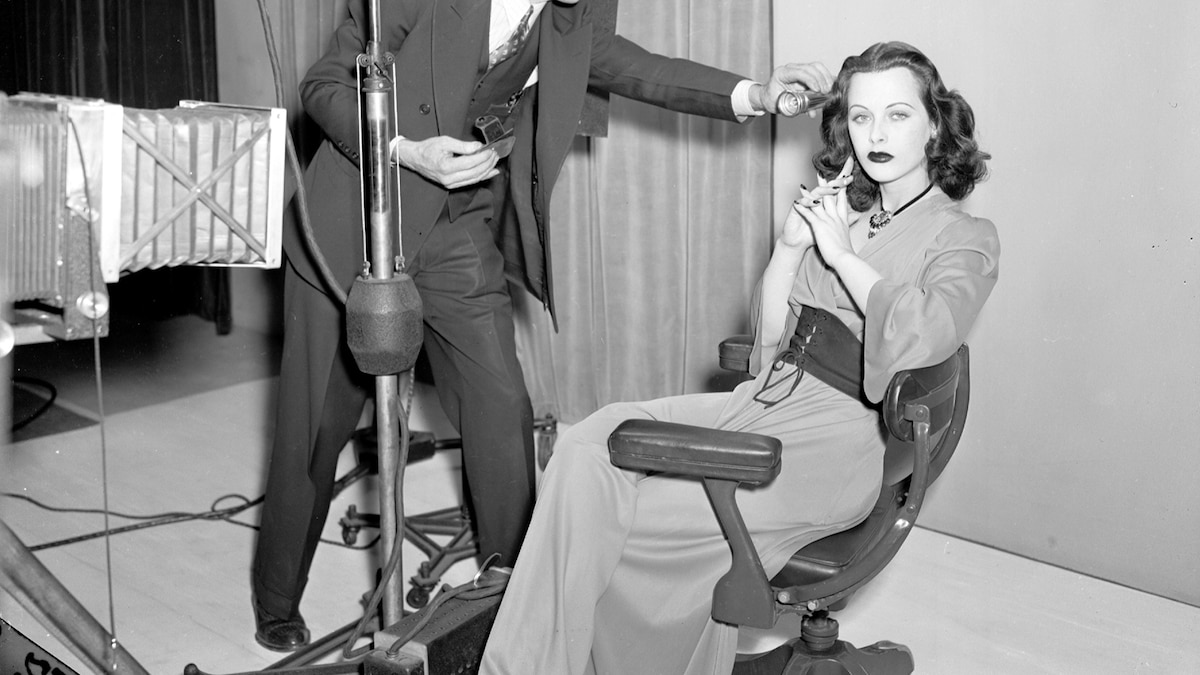Now Reading: This Hollywood movie star helped create Wi-Fi and Bluetooth
-
01
This Hollywood movie star helped create Wi-Fi and Bluetooth
This Hollywood movie star helped create Wi-Fi and Bluetooth

As the world marched toward the second catastrophic world war, film legend Hedy Lamarr posed for publicity photographs and played femmes fatales on the silver screen. But her day job wasn’t always top of mind for the actress, one of the biggest names of Hollywood’s Golden Age.
Lamarr was a technological genius and as she stole Hollywood’s heart in the 1940s, she was busy dreaming up an invention she hoped could help her adopted nation, the United States, keep Nazi Germany at bay.
Lamarr’s idea was a simple yet ingenious way to prevent Axis warships from interfering with secret Allied communications—an idea so good, it became the foundation of modern telecommunications like Wi-Fi and GPS.
But Lamarr’s behind-the-scenes work as an inventor was overshadowed by both her Hollywood glamour and the gender biases of her time, which held that beauty and brains couldn’t coexist. Here’s why Lamarr was more than a pretty face—and how her invention of frequency hopping changed daily life forever.
Who was Hedy Lamarr?
Hedwig “Hedy” Kiesler was born on November 9,I 1914, in Vienna to parents of Jewish ancestry, though her mother converted to Christianity. Known as Austria-Hungary at the time, the area was rampant with antisemitism during the early 20th century. Lamarr would remain secretive about her Jewish identity during her life, historians note, even hiding her Jewish heritage from her own children.
The child of wealthy parents, she grew up in a privileged society and attended private schools alongside other well-to-do children. She was a curious student with a knack for science and engineering but was expected to conform to feminine ideals of the time and prioritize romance and family over a career. Rewarded for her physical appearance over her intelligence, she gravitated toward acting and appeared in her first film in Austria in 1930.
The starlet’s early roles typecasted her as an “innocent-but-seductive Viennese beauty,” writes historian Ruth Barton. Soon, she moved to Berlin in search of wider fame among German-speaking audiences. There, she took acting classes and landed the lead role in 1933’s Ecstasy, a daring film directed by Gustav Machatý. The movie immediately gained renown as an erotic masterpiece, turning heads with its depictions of nudity and sexual pleasure. It launched her into immediate fame, which she translated into a theatrical career and a marriage to wealthy arms dealer Fritz Mandl in 1933.
Mandl’s status as a trusted arms dealer to Italian and German fascists guaranteed his wife a lavish social life. But he was jealous, possessive, and unashamed of his close links to fascism. Mandl’s wide-ranging arms business put his wife in uncomfortable proximity to anti-Semites, Nazis, and fascists. Though the reluctant wife felt increasingly trapped in her relationship, she did enjoy accompanying her husband to meetings with some of Europe’s greatest scientific and technological minds. Eventually she fled her marriage—and 1937, she also fled Europe, where anti-Semitism was on the rise.
(How Operation Paperclip brought Nazi scientists to the U.S.)
When Hedy heard that film magnate Louis B. Mayer was headed to the U.S. on an ocean liner after a vacation, she made a last-minute decision to book herself on the same ship. On board, she managed to meet and captivate Mayer, whose MGM Studios was reaching its pinnacle of productivity, popularity, and profitability. Together, they dreamed up a new identity tailor-made for the camera’s loving lens: Hedy Lamarr, a beautiful but aloof MGM star.
With the help of an on-board makeover and plenty of publicity, Hedy Lamarr was an immediate sensation when she arrived in New York.
What did Hedy Lamarr invent?
In 1938, Lamarr’s breakout role in Algiers made her a bona fide star, and she went on to play seductresses in movies like Lady of the Tropics, Boomtown, and Ziegfield Girl. Though her beauty captivated audiences, her intelligence—and technological genius—remained strictly behind the scenes.
By then, the Second World War had begun, and Lamarr was considering quitting acting and offering her technological abilities to the U.S. to help the war effort. Her inside knowledge of weaponry and arms that she had gained from observing her ex-husband and his clients was also invaluable. Though the U.S. hadn’t yet joined the war, it was already providing supplies to the Allies by sea, and both merchant and military craft faced constant threats from German torpedoes.
Lamarr was up to speed on the latest in European torpedo technology thanks to socializing with her husband’s clients. She was thinking about a way for Allied ships to prevent their radio-controlled torpedoes from being sabotaged by German ships, which often successfully interfered with Allied radio signals and rendered the torpedoes useless. What if the torpedoes and operators instead communicated on more than one signal, “skipping” together to another frequency often to evade German jammers?
In 1940, she met George Antheil, a modernist composer with a love of technology. He immediately realized he was speaking with the smartest woman in the room, he recalled in his 1945 memoir. Hedy is very, very bright,” he wrote. “Compared with most actresses we know, Hedy is an intellectual giant.”
When Lamarr told Antheil about her “frequency-hopping” theory, he was intrigued and was able to build a prototype of the kind of technology she envisioned. He was best known for works that featured synchronized player pianos alongside bells, sirens, airplane propellers, and other jolting sounds—compositions that had almost caused a riot during their Carnegie Hall debut in 1930.
You May Also Like
Antheil helped devise a player-piano-inspired invention that used clockwork and pianola reels to shift operator and receiver to a different frequency together.
Inspired by reports of mounting casualties in the Atlantic, they decided to submit their idea to the newly founded National Inventors Council, a public-private accelerator program designed to fast-track inventions that might help the war effort. In 1942, they received a patent for their “Secret Communications System”—the rights to which they granted to the U.S. Navy.
The concept failed “largely because the invention was well beyond the technical capacities of the time,” wrote historian Lisa A. Marovich in Business and Economic History in 1998. Ultimately, the Navy decided not to move ahead with the device, a rejection Antheil always chalked up to the patent’s mention of player pianos.
As it turns out, the idea was technically sound—just decades ahead of its time.
Hedy Lamarr’s high-tech concept
Lamarr continued her film career, peaking in the 1940s and early 1950s with films like Samson and Delilah before seeing her career decline at the end of the decade. Behind the scenes, her tempestuous off-screen life resulted in six marriages, six divorces, and three children. Lamarr became an American citizen in 1953.
(A strike threatened to cripple Hollywood in 1960. Here’s how they resolved it.)
Meanwhile, the U.S. Navy had been sitting on the technology she had pioneered. But just as Lamarr’s film star began to fall, the Cold War prompted government officials to look back on some of their rejected World War II-era technologies. The Navy began using Lamarr and Antheil’s concepts to develop secure communications systems for a variety of uses, but never publicly credited the inventors.
“Most of the technology being developed by or for the armed forces incorporated Lamarr and Antheil’s frequency-hopping concepts” by the 1960s, wrote Kenneth T. Klima and Adriana Klima in Navy History in 2019. The concept was kept classified until the 1980s.
Yet few knew or acknowledged who had invented frequency-hopping once the concept became part of the public domain. As Lamarr’s star sank, her contribution to technology was hidden in plain sight, in the telephones, televisions, and other new technologies that surrounded her.
But, wrote Klima and Klima, “they received no attribution, royalties, or credit from the military or the communications industry.” For years, there was scant recognition of the invention outside of a jokey 1946 newspaper column claiming that Lamarr’s famous beauty, and her participation in the National Inventors’ Council, had proven a remarkable recruiting tool for would-be inventors.
Her invention with Antheil formed the basis of telecommunications advances like Wi-Fi, Bluetooth and GPS.
An unacknowledged genius
Until recently, Lamarr’s innovation went unacknowledged, even as it became nearly ubiquitous in telecommunications. Meanwhile, the erstwhile Hollywood star tired of public life and became a near recluse, dying in 2000 at age 85.
By then, the scientific world had begun to acknowledge her contributions, and Lamarr and Antheil were honored with awards. But her biggest award, induction into the National Inventors Hall of Fame, came posthumously, acknowledging that Lamarr and her inventing partner “never profited from their invention during their lifetime.”
Did Lamarr realize how important her work would become—or how her work opened new avenues for women in STEM? “She never talked about that part of her life,” said director Alexandra Dean, whose documentary Bombshell: The Hedy Lamarr Story explores the inventor’s life and legacy, in a 2018 interview.
“The unfortunate thing is, I am always way ahead of time,” lamented Lamarr herself in her 1966 autobiography, Ecstasy and Me: My Life as a Woman. “And that is a handicap to me.” Despite being innovative and creative, wrote Lamarr, she had few opportunities to express that side of herself in a world obsessed with her beauty and sex appeal.
(Was red lipstick a symbol of Hollywood glamor or sign of witchcraft?)
“If her dreams of a return to the screen were now past, Hedy’s fondness for invention remained with her until the end,” writes Barton. Her technology has now outlived her, and she is memorialized as both a screen legend and an unexpected founding figure in modern telecommunications.























